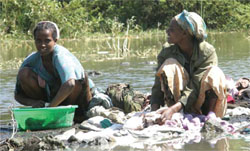33.6.2 Epidemic control measures for cholera
In addition to the points described above, you should take action to prevent the spread of cholera bacteria in water, food or on the hands of people who have been caring for patients.
- Ensure that everyone in contact with the patient knows that they must be especially careful to wash their hands very thoroughly with soap and water after touching the patient, as well as at all the usual times (after defaecation, before preparing food or eating, etc.)
- Make sure that faeces or vomit from the patient cannot contaminate sources of drinking water, for example, when washing the patient’s soiled clothes, bedding or drinking cups. Do not wash any articles that may be carrying cholera bacteria in streams, pools or water containers that people use to collect drinking water (Figure 33.8). Infected water is one of the main transmission modes for cholera bacteria. In a cholera epidemic, everyone in the community must use protected water sources for drinking, and either boil the water or disinfect it by adding chlorine.
- Disinfection of clothes contaminated with faeces and vomit, and articles used by patients, is essential; they should be boiled or scrubbed with a disinfectant solution such as chlorine bleach.
- Interruption of foodborne transmission includes cooking food thoroughly before eating, preventing contamination of food by flies and avoiding eating raw vegetables and fruits.

33.6.1 Controlling epidemics of diarrhoeal diseases
